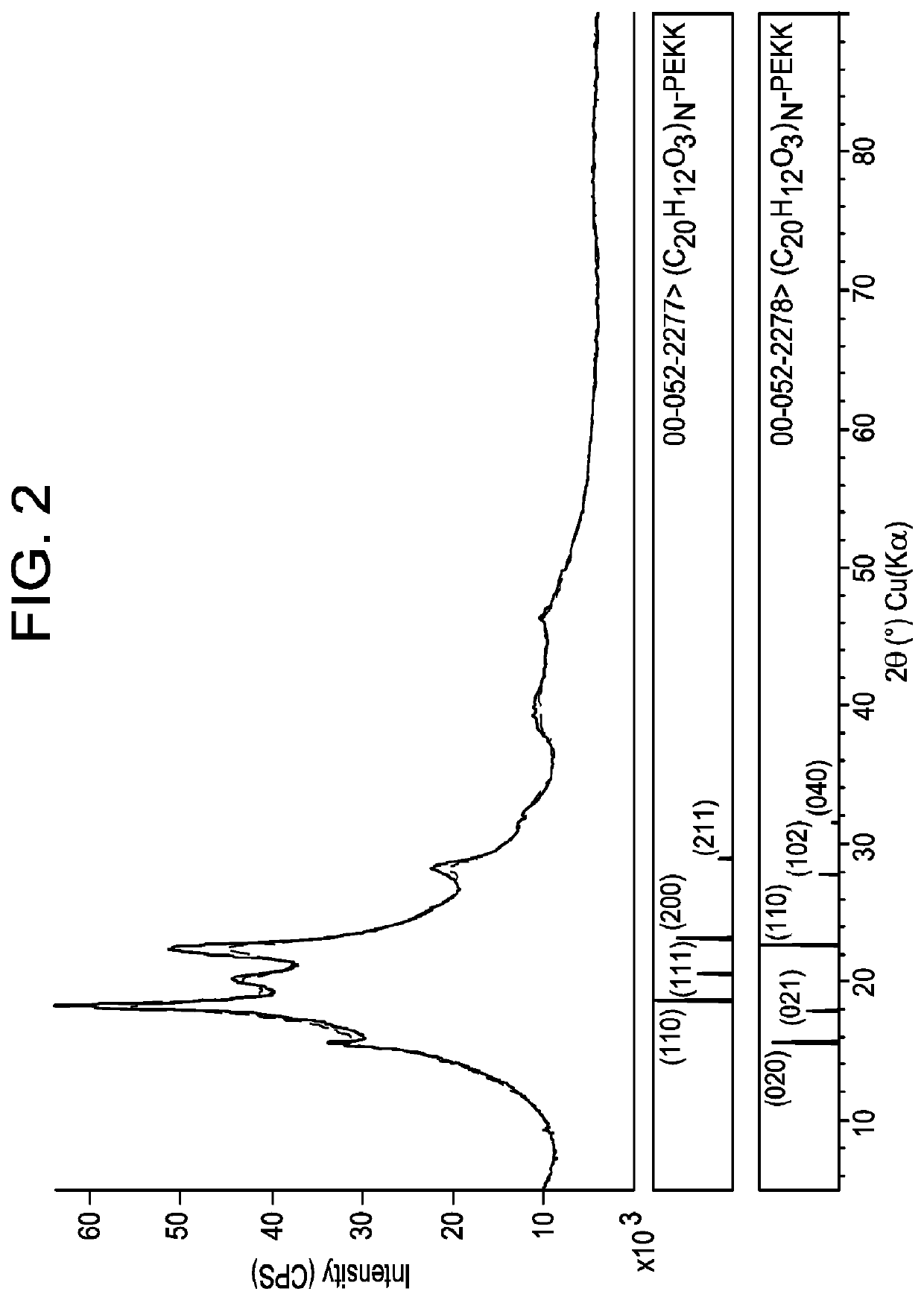Pekk extrusion additive manufacturing processes and products
- Summary
- Abstract
- Description
- Claims
- Application Information
AI Technical Summary
Benefits of technology
Problems solved by technology
Method used
Image
Examples
example 1
[0083]Filament 1.75 mm in diameter was prepared by extrusion with samples PEKK (1) and PEKK (2), having T:I ratios of 60:40 and 70:30 respectively. PEEK filament 1.75 mm in diameter was purchased from Essentium Inc. Filament prepared with PEKK (1) and PEKK (2) was transparent, indicating that the polymer was substantially amorphous. The PEEK filament was opaque, suggesting at least some degree of crystallinity. Modified ASTM D638 Type IV tensile bars were created in a FFF process in both a horizontal and vertical orientation. For all materials, a 0.4 mm diameter nozzle and 0.2 mm layer height was used. PEKK (1) was printed using an extruder temperature of 360° C., PEKK (2) at 375° C. and PEEK at 420° C. PEEK was printed at a higher temperature than PEEK (2) despite its lower melting point because at lower temperatures layer adhesion was too poor to complete a print. A chamber temperature of 75° C., and heated bed of 160° C. was used for all prints. The specimens printed in the horiz...
example 2
[0086]To measure distortions while printing, a long narrow item was printed about the width of two extrusion passes (0.8 mm), about 1 cm tall, and 4 cm long with the printing and crystallization conditions used in Example 1. The percent difference in dimension on the long axis of the printed part (taken in the shortest section) compared to the specified, theoretical length (4 cm) was measured as a way to quantify layer distortion / shrinkage during printing. Table 2 list the percent shrinkage measured for PEEK (2) as printed, PEKK (2) crystallized, PEEK as printed, and an acrylonitrile butadiene styrene amorphous polymer (“ABS”). The results show that PEKK has shrinkage similar to a typical ABS and substantially less than PEEK while printing. Upon crystallizing through the post-process step, the PEKK (2) part experiences further, but uniform shrinkage.
TABLE 2Shrinkage DataMaterial% Distortion on Thin WallPEKK (2) as printed1.2%PEKK (2) after post-processing3.0%* uniform shrinkagePEEK ...
example 3 (
Modeling Example)
[0087]A finite element model tracking temperature and crystallinity was constructed to predict the internal and external crystallinity of a simple 3D printed PEKK 70:30 part consisting of 10 vertically stacked layers that are each 160 mm long, 0.4 mm wide, and 0.2 mm thick. The geometry used by the finite element model of this example is shown in FIG. 7. The model included the following material and process parameters:[0088]1) Temperature of the polymer as it exits the nozzle.[0089]2) Temperature of the heated chamber between 40 C and 240 C.[0090]3) Temperature of a stage supplying heat to the printed part set to 150 C.[0091]4) Physical properties of PEKK with a T:I ratio of 70:30, including density, thermal conductivity, and heat capacity.[0092]5) Print speeds up to 50 mm / s, in particular 10 mm / s and 50 mm / s.[0093]6) Cross sectional area of printed layers defined with 0.4 mm width and 0.2 mm thickness.[0094]7) A parameter to account for the effect of reduced contac...
PUM
| Property | Measurement | Unit |
|---|---|---|
| Temperature | aaaaa | aaaaa |
| Temperature | aaaaa | aaaaa |
| Temperature | aaaaa | aaaaa |
Abstract
Description
Claims
Application Information
 Login to View More
Login to View More - R&D
- Intellectual Property
- Life Sciences
- Materials
- Tech Scout
- Unparalleled Data Quality
- Higher Quality Content
- 60% Fewer Hallucinations
Browse by: Latest US Patents, China's latest patents, Technical Efficacy Thesaurus, Application Domain, Technology Topic, Popular Technical Reports.
© 2025 PatSnap. All rights reserved.Legal|Privacy policy|Modern Slavery Act Transparency Statement|Sitemap|About US| Contact US: help@patsnap.com



